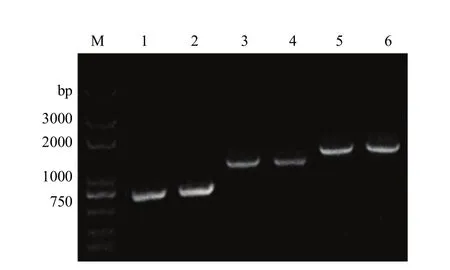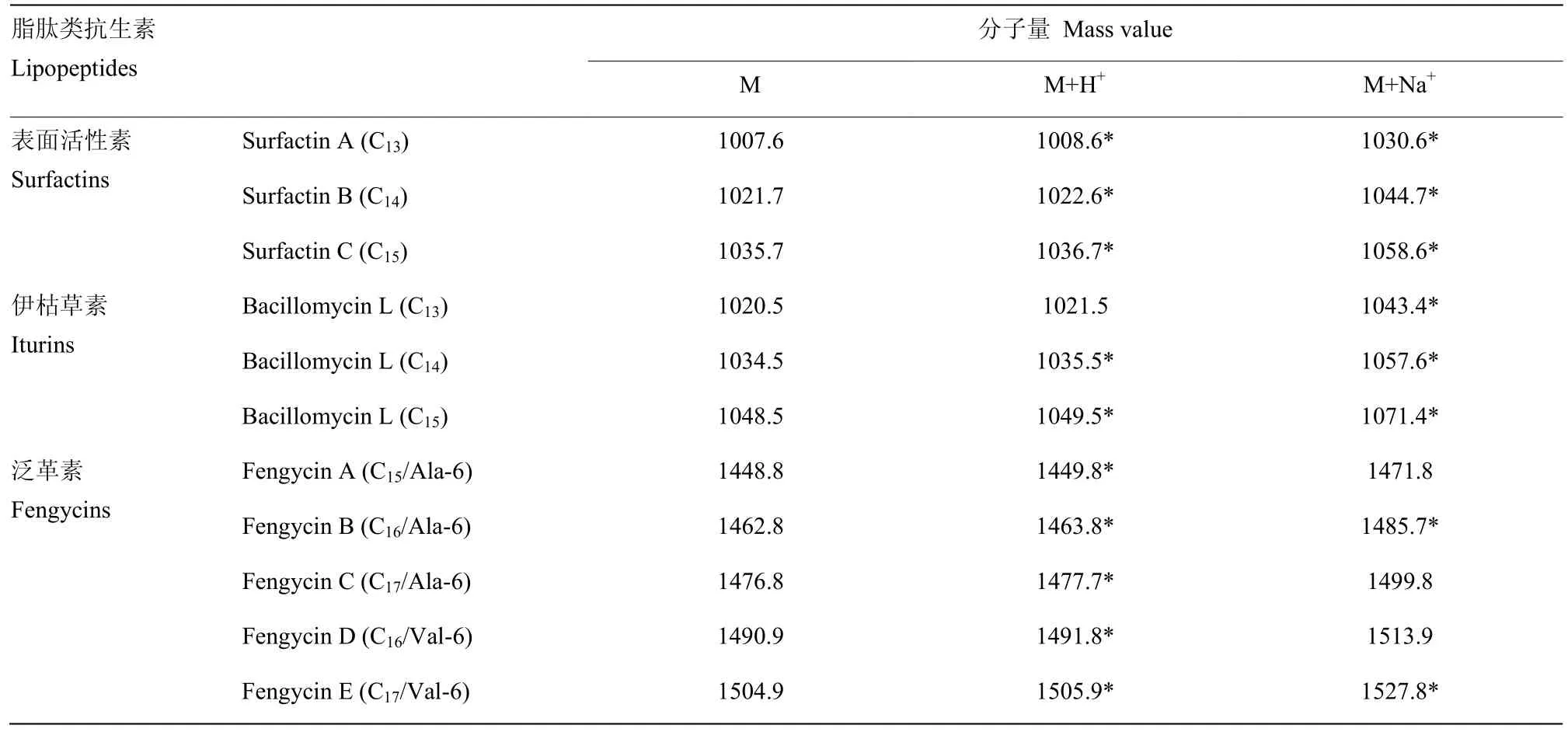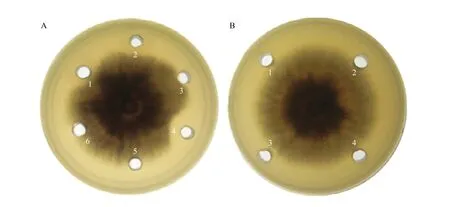解淀粉芽孢杆菌B1619脂肽类抗生素的分离鉴定及其对番茄枯萎病菌的抑制作用
2016-09-16向亚萍周华飞刘永锋陈志谊
向亚萍,周华飞,刘永锋,陈志谊
(1江苏省农业科学院植物保护研究所,南京 210014;2南京农业大学植物保护学院,南京 210095)
解淀粉芽孢杆菌B1619脂肽类抗生素的分离鉴定及其对番茄枯萎病菌的抑制作用
向亚萍1,2,周华飞1,2,刘永锋2,陈志谊1,2
(1江苏省农业科学院植物保护研究所,南京 210014;2南京农业大学植物保护学院,南京 210095)
【目的】从解淀粉芽孢杆菌(Bacillus amyloliquefaciens)生防菌株B1619发酵液上清中分离脂肽类抗生素,分析其抑菌活性相关成分,为应用解淀粉芽孢杆菌B1619菌株防控番茄枯萎病提供依据。【方法】利用特异性引物对B1619中3种脂肽类抗生素合成相关基因sfp、ituA和fenB进行检测;通过盐酸沉淀、甲醇抽提法等方法提取脂肽类抗生素粗提物;用SupelcleanTMLC-18柱及PHASE HF-NH2柱对3种脂肽类抗生素粗提物进行分离;通过MALDI-TOF-MS和HPLC分析、鉴定3种脂肽类抗生素;采用平板对峙培养分别测定3种脂肽类抗生素粗提物对番茄枯萎病菌(Fusarium oxysporum f.sp.lycopersici)的抑菌活性。【结果】从解淀粉芽孢杆菌B1619的基因组DNA中扩增sfp、ituA和fenB等脂肽类抗生素合成基因,扩增产物经克隆、测序分析,表明B1619菌株中含有这3个基因。通过HPLC分析,发现60%甲醇洗脱液分离物分别在12、16.5、18 min处出现相应峰值,保留时间与bacillomycin L标准品一致,分泌量为18.5 mg·L-1;70%甲醇洗脱液分离物分别在22、34、37、51及53 min处出现相应峰值,保留时间与fengycins标准品一致,分泌量为5.1 mg·L-1;100%甲醇洗脱液分离物分别在27、37、41、51及53 min处出现相应峰值,保留时间与surfactins标准品一致,分泌量为74.3 mg·L-1。经液质联用进一步验证分析3种脂肽类抗生素的质子化峰值,60%甲醇洗脱液分离物峰值范围在m/z=1 043.4、1 057.5和1 071.4 Da,是C13—C15的bacillomycin L;70%甲醇洗脱液分离物峰值范围在m/z= 1 463.9、1 477.9、1 491.9和1 505.9 Da,是C15—C17的fengycins;100%甲醇洗脱液分离物峰值范围在m/z=1 008.6、1 022.7和1 036.7 Da,是C13 —C15的surfactins。平板对峙法试验结果表明1 mg·mL-1bacillomycin L和fengycins对番茄枯萎病菌有较强的抑菌效果,而1 mg·mL-1surfactins对番茄枯萎病菌的抑菌活性较弱,再将surfactins的浓度提高至3和6 mg·mL-1,发现其抑菌效果没有明显变化。【结论】B1619菌株分泌3种脂肽类抗生素,其中对番茄枯萎病菌生长起重要抑制作用的抗生素是bacillomycin L和fengycins,surfactins对番茄枯萎病菌的抑制活性较弱。
解淀粉芽孢杆菌B1619;脂肽类抗生素;抑菌活性;番茄枯萎病菌
0 引言
【研究意义】番茄枯萎病是由番茄尖镰孢番茄专化型(Fusarium oxysporum f. sp. lycopersici)引起的一种维管束疾病,现已成为影响番茄生产和品质的重要土传病害。解淀粉芽孢杆菌(Bacillus amyloliquefaciens)是重要的植物根围促生细菌(PGPR),在植物病害生物防治中起重要作用[1]。解淀粉芽孢杆菌B1619菌株是笔者实验室研发的生物杀菌剂发酵菌株之一,能有效防控设施蔬菜枯萎病的发生和危害[2]。芽孢杆菌分泌的脂肽类抗生素是其抑制病原真菌生长的主要抑菌物质之一[3-6],分离与鉴定 B1619分泌的脂肽类抗生素,可为应用 B1619 生物防控设施茄科蔬菜枯萎病提供依据。【前人研究进展】郝晓娟等[7]发现短短芽孢杆菌(Brevibacillus brevis)JK-2菌株对番茄枯萎病有较好的防治效果;詹发强等[8]从大田土壤中分离出一株解淀粉芽孢杆菌(B. amyloliquefaciens GU323369.1)近似种,其在土壤及根中有较好的定殖效果,从而能够抑制番茄枯萎病的发生及扩散。解淀粉芽孢杆菌能够产生多种抗菌物质,解淀粉芽孢杆菌FZB42的全基因组测序揭示了其能产生多种防病促生物质[9],戴秀华等[10]发现解淀粉芽孢杆菌Lx-11可产生蛋白酶、纤维素酶和嗜铁素等物质,而脂肽类抗生素是其最重要的抗菌物质[11-12]。脂肽类抗生素包括伊枯草素家簇iturins(iturin A、iturin C、iturin D、iturin E;bacillomycin D、bacillomycin F、bacillomycin L;mycosubtilin)、泛革素家簇 fengycins和表面活性素家簇 surfactins[4,13-15],但不同种类的脂肽类物质抗菌性能不同,其中iturins和fengycins具有很强的抗真菌活性,而surfactins对病毒、肿瘤、支原体都有很高的抑制活性[5,16-17]。解淀粉芽孢杆菌SWB16分泌的脂肽类抑菌物质fengycins和iturins可以抑制球孢白僵菌(Beauveria bassiana)的生长[18]。ARREBOLA等[19]从水果表面分离出解淀粉芽孢杆菌PPCBO04,发现其抗菌活性物质为iturinA;乔俊卿等[20]发现B1619在番茄根部定殖能力较强,其还可促进植物生长,抑制线虫[21]、治理水环境污染等。【本研究切入点】生防菌B1619能够有效地防控番茄枯萎病,防治效果达到80%左右,其主要控病作用机理是B1619在植物根部定殖,保护植物不受病菌侵染,诱导植株产生抗病性等[20],现已开发成安全、环保、高效的生物杀菌剂“1.2亿活芽孢/g 解淀粉芽孢杆菌B1619水分散粒剂”[22]。然而笔者前期发现生防菌B1619分泌的脂肽类抗生素对番茄枯萎病有直接的抑菌作用。【拟解决的关键问题】分离、鉴定B1619分泌的3种脂肽类抗生素,并研究3种脂肽类抗生素对番茄枯萎病菌生长的抑菌活性及其强弱,为推广应用生物杀菌剂B1619防控番茄枯萎病提供依据。

表1 脂肽类抗生素相关基因引物名称和序列Table 1 Primer names and sequences of the lipopeptide antibiotics corresponding genes
1 材料与方法
试验于 2015年在江苏省农业科学院植物保护研究所完成。
1.1供试菌种
解淀粉芽孢杆菌B1619菌株、番茄枯萎病菌均为笔者实验室保存。B1619菌株所用培养基为 LB (g·L-1):胰蛋白胨10、酵母粉5、NaCl 10。番茄枯萎病原真菌培养基为PDA(g·L-1):马铃薯200、蔗糖20、pH 7.0,28℃培养。
1.2主要试剂及仪器
所用甲醇、乙腈、三氟乙酸等试剂为色谱纯,DNA Marker、Taq DNA聚合酶、DNA提取试剂盒、质粒提取试剂盒和胶回收试剂盒购于北京全式金生物技术有限公司,SupelcleanTMLC-18柱由美国色谱科公司生产,PHASE HF-NH2柱由美国安捷伦公司生产。高速冷冻离心机GL-21M购自湖南湘仪离心机仪器有限公司,Agilent 1100高效液相色谱仪和Agilent 6410三重串联四级杆质谱仪购自美国安捷伦公司,MyCyclerTM梯度PCR仪购自美国BioRad公司,分光光度计购自上海第三分析仪器厂。
1.3脂肽类抗生素合成相关基因克隆
设计扩增sfp、ituA和fenB等基因的引物序列(表1),引物在上海生工生物工程股份有限公司合成。提取解淀粉芽孢杆菌B1619基因组DNA,采用PCR方法进行扩增,sfp、ituA以及fenB大小为预期产物大小,分别为 675、1 150和1 400 bp。
根据所设计引物的退火温度和扩增片段大小设计PCR扩增反应程序。扩增产物经胶回收试剂盒凝胶回收后,连接至 pMD18-T质粒载体,测序在生工生物工程(上海)股份有限公司完成。
1.4脂肽类抗生素的分离和纯化
脂肽类粗提物的提取采用酸沉淀和甲醇提取的方法。B1619在LB培养基中培养72 h后离心除去菌体,上清液用浓盐酸调至pH 2.0沉淀过夜。10 000×g离心25 min得到沉淀,沉淀用甲醇抽提2次(甲醇总体积为发酵液体积的1/10),每次抽提2 h,合并甲醇抽提物。甲醇抽提物减压浓缩后过0.22 µm滤膜,即为脂肽类化合物粗提物。
脂肽类抗生素的分离方法参照LUO等[23-24]。将粗提物采用去离子水稀释为含 30%甲醇水溶液,pH调至7.0,然后上样于NH2固相萃取柱,分别用含50%甲醇水溶液,100%甲醇,含0.5%甲酸甲醇溶液,1%甲酸甲醇溶液,2%甲酸甲醇溶液梯度洗脱,在1%甲酸甲醇洗脱溶液中含有目标化合物。将含 1%甲酸甲醇洗脱溶液的pH调至7.0,氮气吹干浓缩后用去离子水稀释为30%甲醇水溶液,然后上样于C18固相萃取柱;采用3倍柱体积的50%、60%、70%、80%、90% 和100%甲醇水溶液梯度洗脱。将60%、70%、80%、90%和100%甲醇水洗脱液氮气吹干浓缩,再经过真空液氮冷冻仪将不同甲醇水洗脱液干燥成粉。
1.5基质协助激光解吸附离子化-飞行时间质谱(MALDI-TOF-MS)和高效液相色谱(HPLC)检测
为了准确了解菌株产生的脂肽类抗生素种类,对其进行基质协助激光解吸附离子化-飞行时间质谱分析。使用337 nm氮激光源解吸附和电离,采用α-氰-4-羟肉桂酸(α-cyano-4-hydroxycinnamic acid)为基质,1 μL样品与等体积的基质混匀,置于仪器离子源进行测定。质量扫描范围为1 000—2 000 Da,方法参考文献[14]。BacillomycinL、sunfactins及fengycins为笔者实验室前期自主制备[23-24],配制成1 mg·mL-1,作为标准样品。HPLC采用C18柱(微粒大小3.5 µm;柱长及柱直径 25和 41 mm;型号 VYDAC 218 TP;VYDAC,Hesperia,CA);流动相为水∶乙腈∶三氟乙酸(60∶40∶0.5 V/V;50∶50∶0.5 V/V;20∶80∶0.5 V/V);流速为 0.5 mL·min-1;紫外检测波长为210 nm。
1.6脂肽类抗生素对番茄枯萎病菌的抑制作用
将分离的bacillomycin L、sunfactins及fengycins分别配制成浓度为1 mg·L-1的甲醇溶液,与B1619脂肽类抗生素粗提物对比进行抑菌试验;将浓度为1、3 和6 mg·L-1的surfactins对番茄枯萎病菌进行抑菌活性试验,观察其对番茄枯萎病菌的抑菌活性。
将植物病原真菌点接在PDA平板中央,待菌落生长至直径约2 cm后在菌落的四周分别等距离点接脂肽类物质粗提物与3种抗生素分离物。脂肽类物质加100 μL,用甲醇做对照并设置空白对照,每个处理3个重复。逐日观察并记录。
1.7统计方法
采用DPS统计软件进行数据统计与分析。
2 结果
2.1B1619菌株脂肽类抗生素合成基因PCR检测
对解淀粉芽孢杆菌B1619 sfp、ituA以及fenB合成基因 PCR扩增检测结果见图 1,解淀粉芽孢杆菌B1619分别在675、1 150和 1 400 bp左右处出现条带,即能扩增出sfp、ituA以及fenB合成基因。根据分析结果推测解淀粉芽孢杆菌 B1619基因组中可能存在surfactins、bacillomycin L、fengycins代谢合成操纵子序列,该菌株可能代谢产生3类脂肽类抗生素。

图1 PCR扩增脂肽类抗生素相关基因Fig. 1 PCR detection of lipopeptiedes related genes
2.2B1619菌株脂肽类抗生素的HPLC检测
将解淀粉芽孢杆菌 B1619分泌的脂肽类物质的分离物分别进行HPLC检测,结果表明(参考LUO等[23-24]),60%甲醇水洗脱分离物分别在12、16.5、 18 min处出现相应峰值,与bacillomycin L标准品一致,由此可以进一步确定 60%甲醇洗脱分离物是bacillomycin L,其分泌量为18.5 mg·L-1(图2-A);70%甲醇洗脱分离物分别在22、34、37、51及53 min处出现相应峰值,与fengycins标准品一致,由此可以进一步确定分离物fengycins,其分泌量为5.1 mg·L-1(图2-B);100%甲醇洗脱分离物分别在27、37、41、51及53 min处出现相应峰值,与surfactins标准品一致,由此可以进一步确定 100%甲醇洗脱分离物质surfactins,其分泌量为74.3 mg·L-1(图2-C)。
2.3脂肽类抗生素的质谱检测
将解淀粉芽孢杆菌B1619分泌的3种脂肽类抗生素的分离物进行基质辅助解离质谱法测定,B1619产生的3种抗生素对应的特征峰如表2所示。
解淀粉芽孢杆菌B1619的60%甲醇水洗脱液分离物经检测,发现其峰值m/z=1 043.4、1 057.5和1 071.4 Da,相差 14 Da,它们为脂肪酸链相差 1个亚甲基(-CH2-)的同系物,属于C13—C15的bacillomycin L钠离子加合峰;70%甲醇水洗脱液分离物信号谱带在m/z=1 463.9、1 477.9、1 491.9和1 505.9 Da,对应C16 和C17的fengycins,不同的是肽环上6位氨基酸不同,分别为Ala和Val;100%甲醇水洗脱液分离物峰值范围在m/z=1 008.6、1 022.7和1 036.7 Da,它们属于C13—C15的surfactins的质子加合峰(图3)。脂肽类物质质谱峰的分析参考VATER等[25-26]。
2.4对番茄枯萎病菌的抑菌活性
1 mg·mL-1的脂肽类抗生素粗提物以及 3种脂肽类抗生素的分离物对番茄枯萎病菌的抑菌活性见图4,结果表明,3种脂肽类抗生素的分离物中fengycins对番茄枯萎病菌的抑制效果较好图(4-A-2),bacillomycin L活性次之(图4-A-1),而surfactins(图4-A-3)对番茄枯萎病菌没有明显的抑制作用,脂肽类抗生素总粗提物对番茄枯萎病菌的抑制效果较以上三者更为明显(图4-A-4)。浓度为1、3和6 mg·mL-1的surfactins对番茄枯萎病菌活性试验表明,在低浓度1 mg·mL-1(图4-B-1)和3 mg·mL-1(图4-B-2)条件下对番茄枯萎病菌的抑制作用没有明显变化,在高浓度6 mg·mL-1条件下对番茄枯萎病菌有较弱的抑制作用(图4-B-3)。
3 讨论

图2 B1619菌株3种脂肽类物质的HPLC图Fig. 2 HPLC for the lipopeptide antibiotics isolated from B1619

表2 B1619菌株粗提液中脂肽类抗生素surfactins、iturins以及fengycins分子质量测定Table 2 Calculated mass values of bacillomycins, fengycins and surfactins in culture lipopeptides extracts from B1619

图3 B1619菌株3种脂肽类物质MALDI-TOF-MS检测图Fig. 3 MALDI-TOF-MS for the lipopeptide antibiotics isolated from B1619
解淀粉芽孢杆菌可以产生种类繁多的次级代谢产物,主要在非核糖体肽合成酶(NRPS)和聚酮合酶(PKS)的组织下合成,这些产物可以抑制植物根际中的有害细菌和真菌[27]。本研究发现在解淀粉芽孢杆菌生防菌株B1619的NRPS途径中至少产生3种具有抑制番茄枯萎病菌生长的物质,bacillomycin L、fengycins和surfactins。目前国内外对芽孢杆菌脂肽类物质的研究越来越广泛,多数研究者认为 iturins和fengycins具有很强的抗真菌活性,而 surfactins对病毒、肿瘤、支原体都有很高的抑制活性。
ROMERO 等[4]从枯草芽孢杆菌(B. subtilis)UMAF6614发酵液中提取到 iturins、surfactins、fengycins 3类脂肽类抗生素,其中iturins和fengycins对植物病原真菌Podosphaera fusca起主要抑制作用。对桃褐腐病菌(Monilinia fructicola)抑菌试验的研究中发现,在解淀粉芽胞杆菌C06菌株同时产生的脂肽类抗生素bacillomycin D和fengycins中[28],以及在枯草芽孢杆菌 CPA-8菌株产生 fengycins、iturin A和surfactins[29]等多种脂肽类抗生素中,fengycins均发挥主要的作用。在本研究中分离到fengycins,当其浓度为1 mg·mL-1时,对番茄枯萎病菌就有非常明显的抑制作用,其抑菌作用仅次于脂肽类抗生素粗提物。
王雅等[30]在枯草芽孢杆菌Bv10胞外抗菌物质中纯化到iturin A2和iturin A4,两者对芝麻白绢病菌(Sclerotium rolfsii)的抑菌中浓度EC50分别为36.79 和43.03 mg·L-1。从枯草芽孢杆菌M51中分离到脂肽类抗生素iturin A2,当其使用浓度为100 µg·g-1土时就能完全抑制番茄枯萎病菌对番茄的侵染[31]。罗楚平等[3]发现枯草芽孢杆菌Bs916分泌的bacillomycin L能使病原真菌菌丝致畸和抑制孢子萌发,当浓度为500 µg·mL-1时,其对水稻纹枯病和苗瘟的防治效果分别为71%和56%。在本研究中分离到bacillomycin L,当bacillomycin L浓度为1 mg·mL-1时,对番茄枯萎病菌也有明显的抑制作用。从平板抑菌试验结果发现,fengycins的抑菌活性强于bacillomycin L,但是从HPLC 及MALDI-TOF-MS结果分析发现,bacillomycinL的分泌量为fengycins的3.6倍,因此,bacillomycin L和fengycins在B1619抑制番茄枯萎病菌中都起相当重要的作用。

图4 B1619菌株3种脂肽类物质对番茄枯萎病菌的抑菌效果Fig. 4 The inhibition effect of the three lipopeptides antibiotics on F. oxysporum
本研究发现 surfactins在解淀粉芽孢杆菌 B1619中的分泌量较高,但其对番茄枯萎病菌生长的抑制菌活性较弱,这与其他研究结果类似,但其在生防中的其他重要作用不可小觑,是解淀粉芽孢杆菌发挥生防作用的重要基础物质。Surfactins具有较强的表面活性并与细菌生物膜的形成有关,它的表面活性作用可以促进生防菌株在植株上的定殖及扩展[23-24]。BAIS等[32]报道的枯草芽孢杆菌6051分泌的surfactins能使该菌株更好地定殖在拟南芥根部,抵抗丁香假单胞菌的入侵。ONGENA等[33-34]发现,surfactins可以诱导大豆和番茄产生抗病性。任鹏举等[35]也发现芽孢杆菌分泌surfactins对烟草花叶病毒的防治效果显著,且能诱导烟草产生诱导系统抗性。张荣胜等[36]发现解淀粉芽孢杆菌 Lx-11粗提物中含有 surfactins、bacillomycin D 和fengycins等3种脂肽类抗生素,surfactins对水稻细菌性条斑病菌(Xanthomonas oryzae pv. oryzicola)具有较强的抑制作用,是抑制条斑病菌主要物质之一。
在脂肽类抗生素的制备分离中,较常用的为色谱法。别小妹等[37]利用RP-C18柱进行HPLC 分离纯化,并采用硅胶板进行TLC分析,对枯草芽孢杆菌fmbR抗菌物质进行了有效的分离纯化。但此法常用于高纯度脂肽抗生素的分析和制备,但规模小、成本高。本研究利用SupelcleanTMLC-18柱及PHASE HF-NH2柱,以甲醇为洗脱液对脂肽类抗生素粗提物进行分离,用此方法分离的脂肽类抗生素的产量较高,而且吸附柱可以通过再生得到重复利用,从而有效降低生产成本。SUN等[38]利用Sephadex LH-20柱,对解淀粉芽孢杆菌ES-2产生的surfactins和fengycins进行提纯;另外,MUKHERJEE等[39]利用Sephadex G-50将脂肽类抗生素与杂质分离;用XAD-2作吸附色谱柱,也可以从发酵上清液中分离出surfactin类似物的粗产物[40]。
国内外对芽孢杆菌脂肽类化合物的研究已从纯化、特性和鉴定深入到遗传、代谢和机理改造等方面。如通过将脂肽类化合物内源启动子更换为强启动子,构建工程菌株,iturin A 表达量提高了 3倍,mycosubtilin表达量提高了 15倍[3,41]。本研究分析了B1619分泌的脂肽类化合物的种类及抑菌作用,为其今后的开发和应用推广提供理论依据,并为进一步采用基因工程的手段改良生防芽孢杆菌菌株,大幅度提高脂肽类化合物分泌量,特别是脂肽类化合物调控机制的研究打下了基础。
4 结论
通过甲醇梯度洗脱的方法对解淀粉芽孢杆菌B1619菌株分泌的3类主要脂肽类抗生素进行了有效的分离,通过HPLC和 MALDI-TOF-MS分析验证了B1619产生的3种脂肽类物质,其中在对番茄枯萎病菌的抑制作用中起重要作用的抗生素是 bacillomycin L和fengycins,surfactins对番茄枯萎病菌的抑制活性较弱。
References
[1] 胡江春, 薛德林, 马成新, 王书锦. 植物根际促生菌(PGPR)的研究与应用前景. 应用生态学报, 2004, 15(10): 1963-1966. HU J C, XUE D L, MA C X, WANG S J. Research advances in plant growth-promoting rhizobacteria and its application prospects. Chinese Journal of Applied Ecology, 2004, 15(10): 1963-1966. (in Chinese)
[2] 张斌, 杨晓云, 刘邮洲, 陈志谊. 江苏省 3个番茄种植基地枯萎病菌种群数量监测及生防菌B1619的控病效果. 西南农业学报, 2015,28(6): 2521-2526. ZHANG B, YANG X Y, LIU Y Z, CHEN Z Y. Monitoring population dynamics of tomato fusarium wilt and control effect of bio-control bacteria B1619 at 3 tomato planting bases in Jiangsu province. Southwest China Journal of Agricultural Sciences, 2015, 28(6): 2521-2526. (in Chinese)
[3] 罗楚平, 刘邮洲, 吴荷芳, 王晓宇, 刘永锋, 聂亚锋, 张荣胜, 陈志谊. 脂肽类化合物 bacillomycin L抗真菌活性及其对水稻病害的防治. 中国生物防治学报, 2011, 27(1): 76-81. LUO C P, LIU Y Z, WU H F, WANG X Y, LIU Y F, NIE Y F, ZHANG R S, CHEN Z Y. Antifungal activity and rice disease biocontrol performance of lipopeptide antibiotic bacillomycin L. Chinese Journal of Biological Control, 2011, 27(1): 76-81. (in Chinese)
[4] TSUGE K, AKIYAMA T, SHODA M. Cloning, sequencing and characterization of the iturin A Operon. Journal of Bacteriology, 2001,183(21): 6265-6273.
[5] ROMERO D, DE VICENTE A, OLMOS J L, DÁVILA J C,PÉREZ-GARCÍA A. Effect of lipopeptides of antagonistic strains of Bacillus subtilis on the morphology and ultrastructure of the cucurbit fungal pathogen Podosphaera fusca. Journal of Applied Microbiology,2007, 103(4): 969-976.
[6] ZERIOUH H, ROMERO D, GARCIA-GUTIERREZ L, CAZORLA F M, DE VICENTE A, PÉREZ-GARCÍA A. The iturin-like lipopeptides are essential components in the biological control arsenal of Bacillus subtilis against bacterial diseases of cucurbits. Molecular Plant-Microbe Interactions, 2011, 24(12): 1540-1552.
[7] 郝晓娟, 刘波, 谢关林, 葛慈斌, 林抗美. 短短芽孢杆菌JK-2菌株对番茄枯萎病的抑菌作用及其小区防效. 中国生物防治, 2007,23(3): 233-236. HAO X J, LIU B, XIE G L, GE C B, LIN K M. Inhibition of Brevibacillus brevis JK-2 strain against the pathogen of tomato Fusarium wilt. Chinese Journal of Biological Control, 2007, 23(3):233-236. (in Chinese)
[8] 詹发强, 侯敏, 杨蓉, 龙宣杞. 一株番茄枯萎病生防菌的鉴定、定殖与盆栽防效研究. 新疆农业科学, 2013, 50(7): 1277-1287. ZHAN F Q, HOU M, YANG R, LONG X Q. Identification,colonization and control effect of an antagonistic bacterium against Fusarium wilt tomato. Xinjiang Agricultural Sciences, 2013, 50(7):1277-1287. (in Chinese)
[9] Chen X H, Koumoutsi A, Scholz R, EISENREICH A, SCHNEIDER K, HEINEMEYER I, MORGENSTERN B, VOSS B, HESS W R,REVA O, JUNGE H, VOIGT B, JUNGBLUT PR, VATER J, SÜSSMUTH R, LIESEGANG H, STRITTMATTER A, GOTTSCHALK G, BORRISS R. Comparative analysis of the complete genome sequence of the plant growth-promoting bacterium Bacillus amyloliquefaciens FZB42. Nature Biotechnology, 2007, 25(9):1007-1014.
[10] 戴秀华, 张荣胜, 陈志谊. 解淀粉芽孢杆菌Lx-11生物学特性研究.中国生物防治学报, 2014, 30(4): 573-580. DAI X H, ZHANG R S, CHEN Z Y. The biological characterization of Bacillus amyloliquefaciens Lx-11. Chinese Journal of Biological Control, 2014, 30(4): 573-580. (in Chinese)
[11] ZHAO J F, LI Y H, ZHANG C, YAO Z Y, ZHANG L, BIE X M, LU F X, LU Z X. Genome shuffling of Bacillus amyloliquefaciens for improving antimicrobial lipopeptide production and an analysis of relative gene expression using FQ RT-PCR. Journal of Industrial Microbiology & Biotechnology, 2012, 39(6): 889-896.
[12] CHEN X H, KOUMOUTSI A, SCHOLZ R, SCHNEIDER K, VATER J, SÜSSMUTH R, PIEL J, BORRISS R. Genome analysis of Bacillus amyloliquefaciens FZB42 reveals its potential for biocontrol of plant pathogens. Journal of Biotechnology, 2009, 140(1): 27-37.
[13] MOYNE A L, CLEVELAND T E, TUZUN S. Molecular characterization and analysis of the operon encoding the antifugal lipopeptide bacillomycin D. FEMS Microbiology Letters, 2004,234(1): 43-49.
[14] KOUMOUTSI A, CHEN X H, HENNE A, LIESEGANG H,HITZEROTH G, FRANKE P, VATER J, BORRISS R. Structural and functional characterization of gene clusters directing nonribosomal synthesis of bioactive cyclic lipopeptides in Bacillus amyloliquefaciens strain FZB42. Journal of Bacteriology, 2004, 186(4): 1084-1096.
[15] CHEN X H, VATER J, PIEL J, FRANKE P, SCHOLZ R, SCHEIDER K, KOUMOUTSI A, HITZEROTH G, GRAMMEL N,STRITTMATTER A W, GOTTSCHALK G, SÜSSMUTH R D,BORRISS R. Structural and functional characterization of three polyketide synthase gene clusters in Bacillus amyloliquefaciens strains FZB42. Journal of Bacteriology, 2006, 188(11): 4024-4036.
[16] MEENA K R, KANWAR S S. Lipopeptides as the antifungal and antibacterial agents: applications in food safety and therapeutics. BioMed Research International, 2015, 2015: Article ID 473050.
[17] GORDILLO M A, MALDONADO M C. Purification of peptides from Bacillus strains with biological activity//DHANARASU S. Chromatography and Its Applications, InTech, 2012: 201-225.
[18] 汪静杰, 赵东洋, 刘永贵, 敖翔, 范蕊, 段正巧, 刘艳萍, 陈倩茜,金志雄, 万永继. 解淀粉芽孢杆菌SWB16菌株脂肽类代谢产物对球孢白僵菌的拮抗作用. 微生物学报, 2014, 54(7): 778-785. WANG J J, ZHAO D Y, LIU Y G, AO X, FAN R, DUAN Z Q, LIU Y P, CHEN Q Q , JIN Z X, WAN Y J. Antagonism against Beauveria bassiana by lipopeptide metabolites produced by entophyte Bacillus amyloliquefaciens strain SWB16. Acta Microbiologica Sinica, 2014,54(7): 778-785. (in Chinese)
[19] ARREBOLA E, JACOBS R, KORSTEN L. Iturin A is the principal inhibitor in the biocontrol activity of Bacillus amyloliquefaciens PPCB004 against postharvest fungal pathogens. Journal of Applied Microbiology, 2010, 108: 386-395.
[20] 乔俊卿, 刘邮洲, 夏彦飞, 慕少锋, 陈志谊. 生防菌 B1619在番茄根部的定殖及对根际微生态的影响. 植物保护学报, 2013, 40(6):507-511. QIAO J Q, LIU Y Z, XIA Y F, MU S F, CHEN Z Y. Root colonization by Bacillus amyloliquefaciens B1619 and its impact on the microbial community of tomato rhizosphere. Acta Phytophylacica Sinica, 2013,40(6): 507-511. (in Chinese)
[21] 朱丽梅, 吴小芹, 徐旭麟. 松材线虫拮抗细菌的筛选和鉴定. 南京林业大学学报 (自然科学版), 2008, 32(3): 91-94. ZHU L M, WU X Q, XU X L. The screening and identification of the bacterium with nematicidal activity to Bursaphelenchusxy lophilus. Journal of Nanjing Forestry University (Natural Sciences Edition),2008, 32(3): 91-94. (in Chinese)
[22] 明亮, 刘程程, 杨晓云, 储西平, 陆凡, 陈志谊. 生物杀菌剂解淀粉芽孢杆菌 B1619水分散粒剂配方及助剂筛选. 中国生物防治学报, 2015, 31(4): 529-535. MING L, LIU C C, YANG X Y, CHU X P, LU F, CHEN Z Y. Screening on formula and auxiliaries for biological germicide Bacillus amyloliquefaciens B1619. Chinese Journal of Biological Control,2015, 31(4): 529-535. (in Chinese)
[23] LUO C P, LIU X H, ZHOU H F, WANG X Y, CHEN Z Y. Nonribosomal peptide synthase gene clusters for lipopeptide biosynthesis in Bacillus subtilis 916 and their phenotypic functions. Applied and Environmental Microbiology, 2015, 81(1): 422-431.
[24] LUO C P, LIU X H, ZHOU H F, ZOU J C, WANG X Y, ZHANG R S,XIANG Y P, CHEN Z Y. Bacillomycin L and surfactin contribute synergistically to the phenotypic features of Bacillus subtilis 916 and the biocontrol of rice sheath blight induced by Rhizoctonia solani. Applied Microbiology and Biotechnology, 2015, 99: 1897-1910.
[25] VATER J, GAO X W, HITZEROTH G, WILDE C, FRANKE P. “Whole cell”-matrix-assisted laser desorption ionization-time of flight-mass spectrometry, an emerging technique for efficient screening of biocombinatorial libraries of natural compounds-presentstate of research. Combinatorial Chemistry & High Throughput Screening, 2003, 6(6): 557-567.
[26] 何美玉. 现代有机与生物质谱. 北京: 北京大学出版社, 2002. HE M Y. Modern Organic and Biological Mass Spectrometry. Beijing:Beijing University Press, 2002. (in Chinese)
[27] STRIEKER M, TANOVIĆ A, MARAHIEL M A. Nonribosomal peptide synthetases: structures and dynamics. Current Opinion in Structural Biology, 2010, 20(2): 234-240.
[28] LIU J, ZHOU T, HE D, LI D, WU H, LIU W, GAO X. Functions of lipopeptides bacillomycin D and fengycin in antagonism of Bacillusa myloliquefaciens C06 towards Monilinia fructicola. Journal of Molecular Microbiology and Biotechnology, 2011, 20(1): 43-52.
[29] YANEZ-MENDIZABAL V, ZERIOUH H, VIÑAS I, TORRES R,USALL J, DE VICENTE A, PÉREZ-GARCÍA A, TEIXIDÓ N. Biological control of peach brown rot (Monilinia spp.) by Bacillus subtilis CPA-8 is based on production of fengycin-like lipopeptides. European Journal of Plant Pathology, 2012, 132(4): 609-619.
[30] 王雅. 枯草芽孢杆菌菌株Bv10胞外抗菌物质的纯化及其特性测定[D]. 南宁: 广西大学, 2013. WANG Y. Purification and characterization of antimicrobial substances produced by Bacillus subtilis strain Bv10[D]. Nanning: Guangxi University, 2013. (in Chinese)
[31] LEIFERT C, WHITE D, KILLHAM K, MALATHRACIS N E,WOLF G A, LI H. Advances in biological control of plant diseases//Proceeding of the International Workshop on Biological Control of Plant Disease. Beijing: China Agricultural University Press,1996.
[32] BAIS H P, FALL R, VIVANCO J M. Biocontrol of Bacillus subtilis against infection of Arabidopsis roots by Pseudomonas syringaeis facilitated by biofilm formation and surfactin production. Plant Physiology, 2004, 134(1): 307-319.
[33] ONGENA M, JACQUES P. Bacillus lipopeptides: versatile weapons for plant disease biocontrol. Trends in Microbiology, 2008, 16(3):115-125.
[34] ONGENA M, DUBY F, JOURDAN E, BEAUDRY T, JADIN V,DOMMES J, THONART P. Bacillus subtilis M4 decreases plant susceptibility towards fungal pathogens by increasing host resistance associated with differential gene expression. Applied Microbiology and Biotechnology, 2005, 67(5): 692-698.
[35] 任鹏举, 谢永丽, 张岩, 伍辉军, 高学文. 枯草芽孢杆菌 OKB105产生的 surfactin防治烟草花叶病毒病及其机理研究. 中国生物防治学报, 2014, 30(2): 216-221. REN P J, XIE Y L, ZHANG Y, REN H J, GAO X W. Effect and mechanism of controlling TMV disease on tobacco by surfactin produced by Bacillus subtilis OKB105. Chinese Journal of Biological Control, 2014, 30(2): 216-221. (in Chinese)
[36] 张荣胜, 王晓宇, 罗楚平, 刘永锋, 刘邮洲, 陈志谊. 解淀粉芽孢杆菌 Lx-11产脂肽类物质鉴定及表面活性素对水稻细菌性条斑病的防治作用. 中国农业科学, 2013, 46(10): 2014-2021. ZHANG R S, WANG X Y, LUO C P, LIU Y F, LIU Y Z, CHEN Z Y. Identification of the lipopeptides from Bacillus amyloliquefaciens Lx-11 and biocontrol efficacy of surfactin against bacterial leaf streak. Scientia Agricultura Sinica, 2013, 46(10): 2014-2021. (in Chinese)
[37] 别小妹, 陆兆新, 吕凤霞, 赵海珍, 杨胜远, 孙力军. Bacillus subtilis fmbR抗菌物质的分离和鉴定. 中国农业科学, 2006, 39(11):2327-2334. BIE X M, LU Z X, LÜ F X, ZHAO H Z, YANG S Y, SUN L J. Isolation and identification of the antimicrobial substance produced by Bacillus subtilis fmbR. Scientia Agricultura Sinica, 2006, 39(11):2327-2334. (in Chinese)
[38] SUN L J, LU Z X, BIE X M, LU F X, YANG S Y. Isolation and characterization of a co-producer of fengycins and surfactins,endophytic Bacillus amyloliquefaciens ES-2, from Scutellaria baicalensis Georgi. World Journal of Microbiology and Biotechnology,2006, 22(12): 1259-1266.
[39] MUKHERJEE S, DAS P, SIVAPATHASEKARAN C, SEN R. Antimicrobial biosurfactants from marine Bacillus circulans: extracellular synthesis and purification. Letters in Applied Microbiology, 2009, 48(3):281-288.
[40] LIN S C, MINTON M A, SHARMA M M, GEORGIOU G. Structural and immunological characterization of a biosurfactant produced by Bacillus licheniformis JF-2. Applied and Environmental Microbiology,1994, 60(1): 31-38.
[41] LECLERE V, BECHET M, ADAM A, GLUE J, WATHELET B,ONGENA M, THONART P, GANCEL F, IMBERT M, JACQUES P. Mycosubtilin overproduction by Bacillus subtilis BBG100 enhances the organism’s antagonistic and biocontrol activities. Applied and Environmental Microbiology, 2005, 71(8): 4577-4584.
(责任编辑 岳梅)
Isolation and Identification of Lipopeptide Antibiotics Produced by Bacillus amyloliquefaciens B1619 and the Inhibition of the Lipopeptide Antibiotics to Fusarium oxysporum f. sp. lycopersici
XIANG Ya-ping1,2, ZHOU Hua-fei1,2, LIU Yong-feng2, CHEN Zhi-yi1,2
(1Institute of Plant Protection, Jiangsu Academy of Agricultural Sciences, Nanjing 210014;2College of Plant Protection, Nanjing Agricultural University, Nanjing 210095)
【Objective】 Bacillus amyloliquefaciens, biocontrol strain B1619, can effectively prevent and control the occurrenceand damage of tomato fusarium wilt. In order to study and analyze the antifungal substances produced by strain B1619, the lipopeptide antibiotics were isolated from the supernatant of fermented broth.【Method】Three primers designed based on the known lipopeptide genes sfp, ituA and fenB were used to amplify the corresponding genes from the genome of B1619 strain. The crude lipopeptides extracts were extracted by acid precipitation and methanol. The supelcleanTMLC-18 column and PHASE HF-NH2 column were used to separate lipopeptide antibiotics. All the samples were analyzed by HPLC and MALDI-TOF-MS techniques. Inhibition rates of the three lipopeptide antibiotics against Fusarium oxysporum f. sp. lycopersici were tested by dual culture on plate. 【Result】The PCR products with three primer pairs were cloned and sequenced. The result showed that the sfp, ituA and fenB genes existed in the genome of B1619. The HPLC results showed that the peak time of 60% methanol eluent isolates were at 12,16.5 and 18 min, the secretion was 18.5 mg·L-1, and the retention times were consistent with bacillomycin L standards. The peak time of 70% methanol eluent isolates were at 22, 34, 37, 51 and 53 min, the secretion was 5.1 mg·L-1, and the retention times were consistent with fengycins standards. The peak time of 100% methanol eluent isolates were at 27, 37, 41, 51 and 53 min, the secretion was 74.3 mg·L-1, and the retention times were consistent with surfactins standards. The further verification of MALDI-TOF-MS results showed that 60% methanol eluent isolates which m/z were 1 043.4, 1 057.5 and 1 071.4 Da, was C13-C15 bacillomycin L, 70% methanol eluent isolates which m/z were 1 463.9, 1 477.9, 1 491.9 and 1 505.9 Da, was C15-C17 fengycins, 100% methanol eluent isolates which m/z were 1 008.6, 1 022.7 and 1 036.7 Da, was C13-C15 surfactins. The mycostatic tests showed that the antifungal activities of 1 mg·mL-1fengycins were higher than 1 mg·mL-1bacillomycin L, and the 1 mg·mL-1surfactins had the weakest effect on F. oxysporum. However, when the concentration of surfactins was increased to 3 and 6 mg·mL-1, the antifungal activities didn’t change obviously.【Conclusion】B1619 strain secreted the three kinds of lipopeptide antibiotics in which fengycins and bacillomycin L played an important role in the inhibitory effect on F. oxysporum, while the surfactins had no obvious effect on it.
Bacillus amyloliquefaciens B1619; lipopeptide antibiotics; antifungal activities; Fusarium oxysporum f. sp. lycopersici
2015-03-14;接受日期:2016-04-18
国家高技术研究发展计划(“863”计划)(2011AA10A201)、江苏省农业科技自主创新资金(CX(14)2128)
联系方式:向亚萍,E-mail:xiangyaping393@163.com。通信作者陈志谊,Tel:025-84390393;E-mail:chzy84390393@163.com
